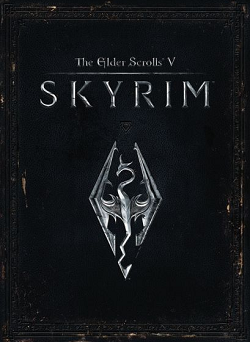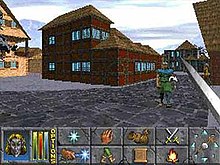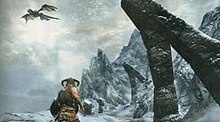Setting
Skyrim is not a direct sequel to Oblivion, but a new chapter in The Elder Scrolls series, set 200 years after the events of Oblivion.[16] The death of Martin Septim, and the end of the Oblivion crisis heralded the beginning of the Fourth Era. A Colovian warlord from Cyrodiil named Titus Mede conquers the Imperial City, beginning the Mede dynasty in absence of the previous Septim bloodline. In the Empire’s weak state, the provinces of Elsweyr, Black Marsh, Valenwood, and the Summerset Isles secede from the Empire. The provinces of the Summerset Isles and Valenwood, home to the Altmer and Bosmer, respectively, create the Aldmeri Dominion, an Elven empire, and rename the founding provinces to Alinor. Thirty years prior to the events of Skyrim, the Thalmor, who govern the Dominion, proceed to invade both Hammerfell and Cyrodiil, beginning “the Great War”, due to a rejection of an ultimatum presented by a Dominion ambassador to the current Emperor, Titus Mede II. The Empire manages to survive the Thalmor assault by agreeing to sign the White-Gold Concordat, a treaty which prohibits the worship of Talos throughout the Empire. Following the end of the Great War, the Blades, a secret order of warriors devoted to the protection of the Emperor of Tamriel, are hunted down and killed by the Thalmor, or else seclude themselves from the rest of the world. The Emperor is protected instead by an elite Imperial security force known as the Penitus Oculatus. Ulfric Stormcloak, the Jarl of Windhelm, establishes the Stormcloak faction and rebels against the Empire in order to liberate Skyrim after the ban of Talos worship. This culminates in Ulfric killing Skyrim’s High King, Torygg, in a duel. The Empire responds to the death of the High King by deploying the Imperial Legion to quell the rebel threat.
As with previous The Elder Scrolls games, Skyrim begins with the player character as an unknown prisoner. The player was caught in an Imperial ambush while attempting to cross the border into Skyrim, on a wagon with several Stormcloak soldiers, Ulfric Stormcloak himself, and a horse thief. They are all headed to Helgen to be executed. As the player character is about to be beheaded, a Dragon arrives, interrupting the execution and destroying the town. The player eventually learns that Skyrim’s civil war is the last in a sequence of prophetic events foretold by the Elder Scrolls, which also predicted the return of Alduin, the Dragon-god of destruction. Alduin is prophesied to destroy the races of Men and Mer, and consume the world. The player character is the latest “Dovahkiin”, a Dragonborn, an individual with the body of a mortal and the soul of a Dragon. Dovahkiin are anointed by the gods to help fend off the threat Alduin and other dragons pose to Skyrim and Tamriel. Among the individuals aiding the player are Delphine (voiced by Joan Allen) and Esbern (voiced by Max von Sydow), two of the last remaining Blades, and Master Arngeir (voiced by Christopher Plummer), a member of the Greybeards.[16]
Plot
Following the Dragon attack on Helgen, the player character may choose to escape either with Hadvar, an Imperial soldier, or Ralof, a Stormcloak rebel. After the escape, the player travels to the town of Riverwood. The player is asked to journey to the city of Whiterun, and request aid from the Jarl against the Dragon threat. The Jarl agrees to send soldiers to Riverwood, but asks that the player retrieve a Dragonstone. The player discovers a Word Wall in the process, learning their first “Thu’um”, one of the dragon shouts, in the process.
Upon returning to Whiterun, the player is asked to assist in defending the city from an attacking Dragon. After defeating the Dragon, the player character absorbs the Dragon’s soul. This gives the player great power. Astonished, the Whiterun soldiers tell the player that they may be a “Dragonborn”, a mortal with the soul of a dragon. After returning to the Jarl with news of the Dragon’s defeat, the player is summoned to meet with the Greybeards, an order of monks who live in seclusion in their temple of High Hrothgar on the slopes of Skyrim’s highest mountain, the Throat of the World. The Greybeards further train the player in the “Way of the Voice”, teaching the player more powerful Thu’ums and instructing the player on their destiny and role of the Dragonborn. As a further test, the Greybeards task the player with retrieving the legendary Horn of Jurgen Windcaller. However, the player discovers the Horn has been stolen by another, who wishes to meet with the Dragonborn. The thief reveals herself as Delphine, Riverwood’s innkeeper and one of the last surviving members of the Blades. Delphine and the player witness Alduin reviving a Dragon from a burial mound and defeat the Dragon. Afterwards, Delphine helps the player infiltrate the Thalmor Embassy near Solitude, the headquarters of the Aldmeri Dominion in Skyrim, to follow up on her suspicions about the Thalmor’s possible involvement with the Dragon threat. While there, Delphine and the player discover the Thalmor are searching for a man named Esbern, an archivist of the Blades Order. Delphine then instructs the player to locate Esbern, known to be hiding in the sewers and ratways of Riften.
The player character accompanies the Blades in search of “Alduin’s Wall”, located in an ancient Blades fortress known as Sky Haven Temple. While the Blades set up in the temple, the player character learns that the ancient Nords used a special Thu’um against Alduin called “Dragonrend”, representing mankind’s comprehensive hatred for the Dragons, to cripple his ability to fly so they could engage him. To gain more information, the player meets the leader of the Greybeards, an ancient Dragon, and once one of Alduin’s most feared generals, named Paarthurnax. Paarthurnax reveals that Alduin was not truly defeated in the past, but was sent forward to an unspecified point in time by the use of an Elder Scroll, in the hopes that he would get lost. The player manages to locate the Elder Scroll within the Dwemer ruin of Blackreach and uses it to travel back in time, learning the powerful Dragonrend Shout to combat Alduin.
Armed with the knowledge of how the ancient Nords defeated Alduin, the player battles Alduin on the summit of the Throat of the World. Overpowered by the player, Alduin flees to Sovngarde, the Nordic afterlife. The player learns that Dragonsreach, the palace of the Jarl of Whiterun, was originally built to trap and hold a dragon. The Jarl refuses to allow the player to utilize Dragonsreach and possibly endanger the city if the civil war between the Stormcloaks and the Imperial Legion still rages. With the help of the Greybeards, the player calls a council between General Tullius and Ulfric Stormcloak, successfully calling for a temporary armistice while the Dragon threat exists. If the war has already ended the Jarl will eventually agree with persuasion.
The player summons and traps a Dragon named Odahviing in Dragonsreach, learning from him that Alduin has fled to Sovngarde through a portal located high in the mountains, at an ancient fort called Skuldafn. Odahviing, impressed with the player’s Thu’um and ability to capture him, agrees to fly the player to Skuldafn, claiming Alduin has shown himself as weak and undeserving of leadership over the Dragons. Upon arrival at Skuldafn, the player travels to Sovngarde and meets with Ysgramor, the legendary Nord who, along with his Five Hundred Companions, drove the Elves out of Skyrim. Ysgramor informs the player that Alduin has placed a “soul snare” in Sovngarde, allowing him to gain strength by devouring the souls of deceased Nords arriving there. The player meets up with the three heroes of Nordic legend who defeated Alduin originally, and, with their help, destroys the soul snare, defeating Alduin.
If the player did not kill Paarthurnax in an earlier side quest, an alternate conclusion is given. The player returns to the summit of the Throat of the World in which Paarthurnax and the other Dragons wait. Paarthurnax explains that even if Alduin is defeated, they are in no condition to celebrate for he was once their ally and is still one of their kin. The Dragons leave and the player is left to continue the adventure.

























